BestReviews is reader-supported and may earn an affiliate commission. Details
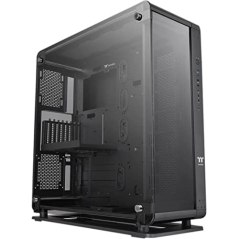
A large, striking, feature-packed case that supports liquid cooling and can be operated closed or open.
A flagship full-size case. Fits E-ATX motherboards and smaller. Built for water cooling and supports radiators up to 480 millimeters up front and 360 millimeters on top. Wears two USB 3.0 ports, two USB 2.0 ports, one USB Type-C port, and one HD audio port on the front panel. Components protected by 4-millimeter tempered glass panels. Can be transformed into an open frame chassis.
Case is large, heavy, and expensive. Many users note that instructions are hard to follow and assembly is difficult.
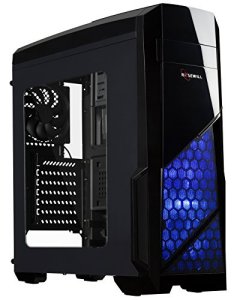
With the LED fan and side window, this mid tower case offers a very good look at a low price, but it suffers a bit in areas such as cable management and durability.
Very attractive price. Comes with three pre-installed fans: two 120-millimeter blue LED fans in the front, and one 120-millimeter fan in the rear. Expandable up to seven PCI-E slots, with space for a 154-millimeter CPU cooler and up to a 380-millimeter graphics card. Good air flow. Side window.
Cable management area is a little tight. Space to install a DVD/CD drive is the wrong size. Some buyers say that this case isn't too durable.
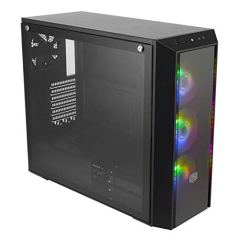
ARGB fans really add to both the aesthetic and air flow here, although issues with the fans and case may put off some buyers.
Comes in several sizes and colors. Pre-installed with three 120-millimeter ARGB fans in the front, with support for a total of six 120-millimeter fans. Nice size and quality. Tempered glass side panel. Runs quiet. Has a PSU cover. Nice look.
PSU cover is flimsy. No place to install a DVD/CD player. Front cover impedes air flow.

Its high quality and durability, along with a slew of features and extras, draw a lot of praise for this mid-price, mid tower case.
Available in several different colors and color combinations. Full-metal body, with a tempered glass side panel. Features a removable HDD cage, 10-color RGB downlight and power strip, and two 120-millimeter fans. Support for radiators. Nice build. Buyers love the cable management. Comes with a PSU cover. Decent price.
Some buyers report that this case arrives damaged, missing parts, or in the wrong color. USB ports may not be very durable.
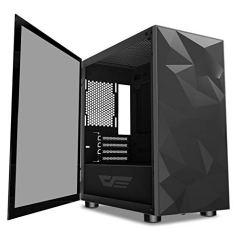
A clever, well-made mini tower case with a magnetic door for easy maintenance.
Magnetic door with tempered glass panel swings wide for easy access to internal components. Supports Mini-ITX and Micro-ATX motherboards. Up to six fans can be installed. Case is also compatible with a 240-millimeter water cooler. Available in 10 different styles.
This tower has no RGB lighting. Airflow could be better.
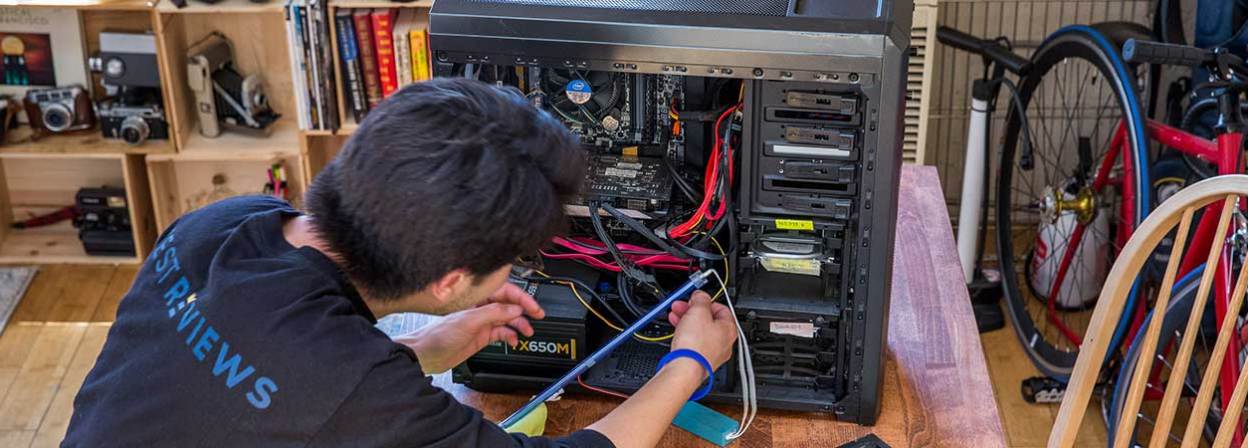
We recommend these products based on an intensive research process that's designed to cut through the noise and find the top products in this space. Guided by experts, we spend hours looking into the factors that matter, to bring you these selections.

In many ways, a PC tower case is like the body of a car. Both are built primarily to house the internal components, but their designs go a long way toward determining overall functionality and efficiency. Also, it’s where owners can tweak the look and “personality” of their machines to make them their own.
Specifically, PC tower cases are where your computer components live. The motherboard, processor (CPU), graphics card (GPU), storage drives, and memory are all mounted inside, with the display, keyboard, mouse, and speakers resting outside the case. Physical dimensions and interior layout are paramount considerations here because they determine what parts will fit, how upgradable your computer will be, how easy it will be to access parts, and how healthy the airflow will be. The last point is absolutely vital because without proper cooling, your computer may not function properly or safely.
Tower cases come in myriad sizes, shapes, and colors, with near-endless personalization options.

Tower cases come in a variety of sizes, which is necessary because CPUs, GPUs, motherboards, and fans do as well. To determine what size you need, start with your motherboard. Cases are designed to work with specific motherboards, and product descriptions typically specify which are compatible. This is why it’s important to gather your PC parts first and find the appropriate case second. (The size of the motherboard is the primary concern here, but keep the length of your GPU and the size of your CPU cooler in mind, too. They can get quite beefy.)
Cases are generally sold in four sizes:
Mini-ITX or small-form-factor cases are the smallest in use today, but they’re quite popular because of the tiny footprint. You’re limited to the diminutive mini-ITX motherboard in this case, and you’ll run into size limitations with other components as well. Mini-ITX cases get high marks for portability and minimalism, however.
Mini cases are slightly larger and support mini-ITX motherboards as well as micro-ATX motherboards. This opens up your possibilities significantly, but you may still run into space issues for beefier builds.
Mid cases are the go-to for a reason: they’re versatile, affordable, and fit mini-ITX, micro-ATX, ATX, and even some e-ATX (extended) motherboards, depending on the model. The footprint is the second largest, but mid towers are still sleek enough to blend in. Internal volumes are large enough to satisfy the majority of users.
Full cases are the largest available and are typically chosen for e-ATX motherboards that measure 13 inches long. Headroom is absolutely stellar in a full tower, but you can still use smaller motherboards inside if you wish.
Healthy airflow and proper cooling are principal concerns when shopping for a PC tower case, particularly if the machine inside will be used for gaming or other intense processes. Some brands provide airflow diagrams to illustrate their build philosophies, but user reviews are great resources for this as well.
While airflow is key, PC tower cases have fans to cycle air in and out. We recommend cases with two fans at a minimum: an intake to bring cool air in and an exhaust to push hot air out. More is better, though, and manufacturers often include additional fan mounts so you can expand the unit’s cooling abilities.
Drive bays are another prime concern because you need to have space…for your space. Specifically, 2.5-inch and 3.5-inch drive bays house your computer’s storage drives, solid state drives (SSD), and hard disk drives (HDD), respectively. Some tower cases have additional SSD mounting points on the rear of the motherboard tray as well.
If you use a lot of external devices, you’ll be fiddling with your PC’s front panel often. It’s where you’ll be plugging in USB devices, headphones, phone chargers, and even external monitors, so the more ports the better. Basic tower cases usually have a couple of USB ports, a 3.5-millimeter headphone jack, and not much else, so you might want to budget for a busier front panel. Outside of USB and 3.5-millimeter, common connectivity options include microphone inputs, HDMI ports, VGA ports, SD card readers, optical drive ports, and others.
Cable management may not seem like a huge deal, but cluttered cords go a long way toward making a clean workspace look messy. Basic PC cases have simple holes punched in the motherboard tray to hide cables, but manufacturers have devised myriad clever tools to improve on this. Some have rubber grommets and clips, while others have dedicated cutouts to keep cables out of sight and out of mind.
A PC tower case with a tempered-glass window has several advantages over a case without one. It’s safer than non-tempered glass in case of a break, it offers higher resistance to both heat and scratching, and it’s smoother and clearer than other materials.
There’s nothing wrong with adding a bit of personalization to your PC setup, and RGB lighting is a great way to add flair to your space. RGB tech is everywhere nowadays; in fact, it’s probably fairly difficult to find a PC tower case without RGB in today’s market. Pick the design that’s right for your taste, and remember, you can always turn it off.
Water cooling is significantly more efficient than air cooling, generally speaking, but you need a proper setup to do it right. Part of that proper setup involves a PC tower case with liquid-cooling radiator mounts. Keep in mind that mini-ITX cases almost never have water-cooling support, and mid tower cases limit you on both radiator size and radiator placement. So, while you’ll definitely pay extra for a large and compatible tower case, it could very well be worth it.
In the past, doing any work “under the hood” of your computer involved breaking out a Phillips screwdriver. Thankfully, those days are long gone because toolless designs are nearly universal in PC tower cases above the entry-level. These typically have easy-to-use and headache-reducing thumbscrews and tabs for quick assembly and disassembly.

Inexpensive: Computers can get expensive fast, but, thankfully, entry-level tower cases can be found for less than $50. Expect to find smaller mini and mid cases at this price point, with fewer fans, external ports, and lighting options as standard. You can still find a sub-$50 case with two fans, though, and we strongly recommend doing so.
Mid-range: For $50 to $150, you’re opening yourself up to features like water-cooling compatibility, toolless designs, and customizable RGB lighting. The features you opt for are up to you, but on the whole, you can expect to encounter mid and full cases here with more fans, better airflow, and increased motherboard compatibility,
Expensive: Spend $200 or more and you’re into the high-end full tower cases. These models are often built for specific purposes, such as high-performance gaming or streaming with maximum cooling. You’ll see ultra-quiet cases at this price point, too, as well as some examples that are just plain huge. As you might expect, this range offers the full gamut of RGB lighting, external port choices, and other personalization options.
Aesthetics are inherently subjective, but a large, clear viewing window is usually a plus for a PC tower case. Not only does it look pretty with RGB lighting, it also makes visual maintenance checkups a snap.

A. As we mentioned above, you need to start with your motherboard. This is the biggest factor in determining case size because smaller cases simply don’t have the real estate for large motherboards. Mounting systems may differ between categories as well, so it’s best to stick with what the case is designed for as noted in the product description.
Another way to know is to follow a simple naming convention. Motherboards come in four sizes. From smallest to largest, they are: mini-ITX, micro-ATX, ATX, and e-ATX. Cases often follow a similar naming convention, meaning an ATX case is built for an ATX motherboard, an ITX case is made for an ITX motherboard, and so forth.
An important thing to remember is that small motherboards can work fine in larger cases. This means a mini-ITX motherboard can fit in a micro-ATX, ATX, or e-ATX case. You’ll just have some extra room in there. The inverse is not true, however, because an e-ATX motherboard simply won’t fit in a mini-ITX case.
A. PC tower cases cycle a lot of air to keep components cool, and that often brings dust with it. We recommend cleaning the inside of your case every six months or so, but you may need to do it more often if you notice excessive buildup. Here’s how to do it:
A. Expansion slots are the key to upgradability. PC tower cases often offer expansion slots in addition to the included drive bays, allowing users to plug in new hardware to their machine without taking anything out. The most common styles are AGP, PCI, and PCI Express slots, which are used for video cards, network cards, sound cards, and modems.
Get emails you’ll love.
Learn about the products you’re wondering if you should buy and get advice on using your latest purchases.
